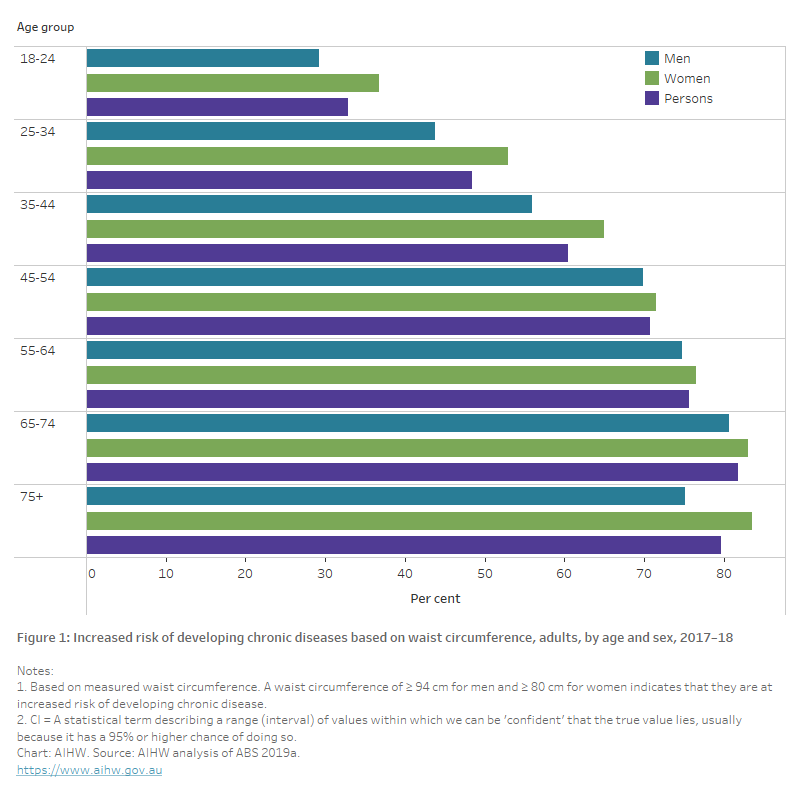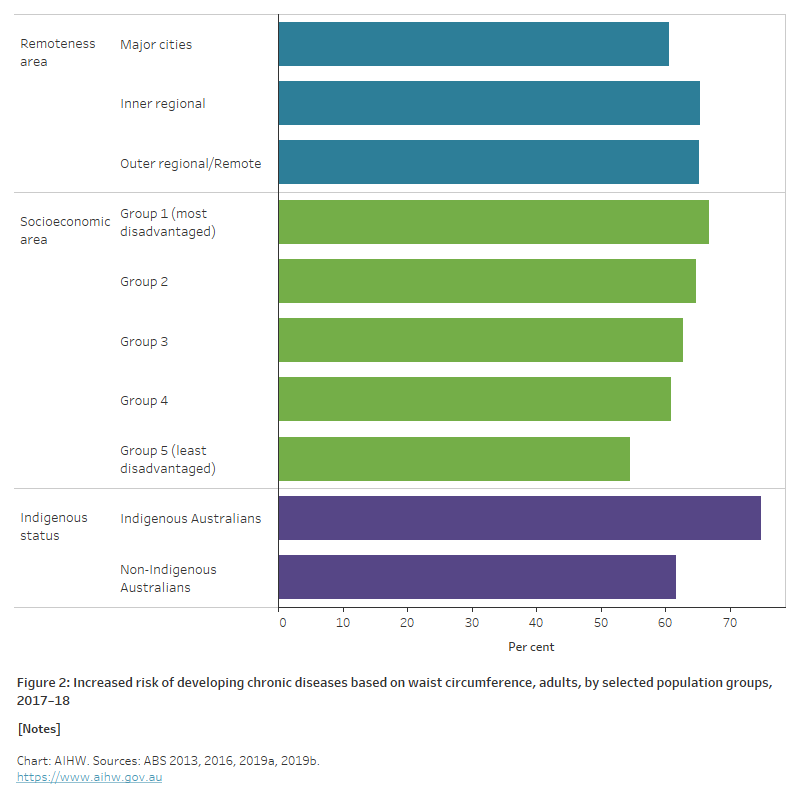Waist circumference
Based on the latest available measured data from the Australian Bureau of Statistics (ABS) 2017–18 National Health Survey (NHS):
- An estimated 63% of Australian adults had a waist circumference that put them at an increased risk of chronic disease, including type 2 diabetes.
- The proportion of men and women with an at-risk waist circumference generally increased with age, with 81% of men aged 65–74 and 84% of women aged 75 and over (Figure 1).
After adjusting for differences in the age structure of the populations:
- Women were 1.1 times more likely to have a waist circumference that put them at increased risk of chronic disease than men.
- The proportion of people with an at-risk waist circumference has remained steady since 2011–12 (AIHW analysis of ABS 2013, ABS 2016 and ABS 2019a).
Waist circumference for adults is a good indicator of total body fat and is a better predictor than body mass index (BMI) for certain chronic conditions such as cardiovascular risk and type 2 diabetes (NHMRC 2013). A waist circumference above 80 cm for women and 94 cm for men is associated with an increased risk of chronic conditions. A waist circumference above 88 cm for women and 102 cm for men is associated with a substantially increased risk of chronic conditions (WHO 2000).
Figure 1: Increased risk of developing chronic diseases based on waist circumference, adults, by age and sex, 2017–18
The bar chart shows the proportion of adults with increased risk of developing chronic diseases based on waist circumference, by age and sex in 2017–18. The proportion of men and women with an at-risk waist circumference generally increased with age, with 81% of men aged 65–74 and 84% of women aged 75 and over.

Variation between population groups
After adjusting for different population age structures, the proportion of people with an at-risk waist circumference:
- was 1.2 times higher among those living in the lowest socioeconomic areas compared with those in the highest socioeconomic areas
- was 1.1 times higher among people living in both Inner regional and Outer regional and remote areas compared with those living in Major cities
- was 1.2 times higher for Indigenous adults compared with non-Indigenous adults based on data from the 2018–19 National Aboriginal and Torres Strait Islander Health Survey (NATSIHS) and 2017–18 NHS (Figure 2).
Figure 2: Increased risk of developing chronic diseases based on waist circumference, adults, by selected population groups, 2017–18
The bar chart shows the proportion of adults with increased risk of developing chronic diseases based on waist circumference, by selected populations groups in 2017–18. The proportion of people with an at-risk waist circumference was higher among Indigenous Australians, people living in inner regional and outer regional and remotes areas, and people living in the lowest socioeconomic areas.

ABS (Australian Bureau of Statistics) (2013) Microdata: Australian Health Survey, National Health Survey, 2011–12, AIHW analysis of detailed microdata, accessed 1 December, 2021.
ABS (2016), Microdata: National Health Survey, 2014–15, AIHW analysis of detailed microdata, accessed 1 December, 2021.
ABS (2019a), Microdata: National Health Survey, 2017–18, AIHW analysis of detailed microdata, accessed 1 December, 2021.
ABS (2019b), Microdata: National Aboriginal and Torres Strait Islander Health, Australia, 2018–19, AIHW analysis of detailed microdata, accessed 1 December, 2021.
NHMRC (National Health and Medical Research Council) (2013) Clinical practice guidelines for the management of overweight and obesity in adults, adolescents and children in Australia, NHMRC, Australian Government, accessed 15 December 2021.
WHO (World Health Organization) (2000) Obesity: preventing and managing the global epidemic: report of a WHO consultation, WHO, accessed 15 December 2021.


